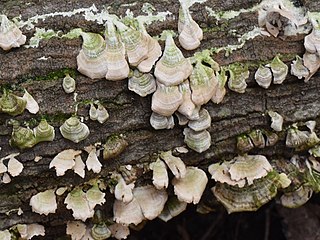
Trichaptum abietinum is a species of poroid fungus in the order Hymenochaetales. It is saprophytic, growing from dead conifer wood.

Trichaptum biforme is a species of poroid fungus in the order Hymenochaetales. It is a saprobe that decomposes hardwood stumps and logs.

Phylloporia is a genus of polypore fungi in the family Hymenochaetaceae. A 2012 estimate placed 23 species in the genus; this number was increased to 30 by 2015.

Haploporus is a genus of poroid fungi in the family Polyporaceae.

Trichaptum is a genus of poroid fungi. The genus was circumscribed by American mycologist William Alphonso Murrill in 1904. Formerly classified in the family Polyporaceae, several molecular studies have shown that the genus belongs to the order Hymenochaetales.
Megasporoporia is a genus of four species of crust fungi in the family Polyporaceae. The genus is characterized by its large spores, and dextrinoid skeletal hyphae.

Skeletocutis is a genus of about 40 species of poroid fungi in the family Polyporaceae. The genus has a cosmopolitan distribution, although most species are found in the Northern Hemisphere. Skeletocutis causes a white rot in a diverse array of woody substrates. Their fruit bodies grow as a crust on the surface of the decaying wood. Sometimes the edges of the crust are turned outward to form rudimentary bracket-like caps.

Phellinus ellipsoideus is a species of polypore fungus in the family Hymenochaetaceae, a specimen of which produced the largest fungal fruit body ever recorded. Found in China, the fruit bodies produced by the species are brown, woody basidiocarps that grow on dead wood, where the fungus feeds as a saprotroph. The basidiocarps are perennial, allowing them to grow very large under favourable circumstances. They are resupinate, measuring 30 centimetres (12 in) or more in length, though typically extending less than a centimetre from the surface of the wood. P. ellipsoideus produces distinct ellipsoidal spores, after which it is named, and unusual setae. These two features allow it to be readily differentiated microscopically from other, similar species. Chemical compounds isolated from the species include several steroidal compounds. These may have pharmacological applications, but further research is needed.
Trichaptum imbricatum is a species of fungus in the family Polyporaceae. It is distinguished by its imbricate basidiocarps, white to cream hymenophores, small and regular pores, and scattered and thin-walled cystidia. It was first isolated from China.
Trichaptum perenne is a species of fungus in the order Hymenochaetales. It differs from species in its genus by its perennial and pileate habit, its large pores and dissepiments, and oblong, ellipsoid basidiospores. It was first isolated from China.
Inonotus rigidus is a species of fungus in the Hymenochaetaceae family. It is distinguished by its resupinate and rigid basidiocarps, its yellow pore surface, being microscopically ellipsoid and yellowish brown, its thick-walled basidiospores, and by lacking both setal hyphae and hymenial setae.
Inonotus chrysomarginatus is a species of fungus in the Hymenochaetaceae family. It is distinguished by having an annual to perennial growth habit, pileate basidiocarps, setal hyphae and hooked hymenial setae, and sublobose, yellowish, thick-walled cyanophilous basidiospores.
Inonotus acutus is a species of fungus in the Hymenochaetaceae family. It is characterized by having small and thin basidiocarps, a sharp pileus margin, ventricose hymenial setae, and ellipsoid, yellowish and thick-walled basidiospores.
Bondarzewia podocarpi is a species of polypore fungus in the family Russulaceae. Described as new to science in 2010, it is found in Hainan, China, where it grows parasitically on Podocarpus imbricatus.
Megasporoporia minuta is a species of crust fungus in the family Polyporaceae. Found in the Guangxi Autonomous Region of southern China, it was described as a new species in 2008 by mycologists Xu-Shen Zhou and Yu-Cheng Dai. The fungus produces annual to biennial fruit bodies with small pores, numbering 6–8 per millimetre. The spores are cylindrical to oblong-ellipsoid and measure 7.7–9.7 by 3.6–4.9 μm. The hymenium lacks both hyphal pegs and dendrohyphidia.
Pyrofomes castanopsidis is a species of polypore fungus in the family Polyporaceae. It was described as new to science in 2011 by Chinese mycologists Bao-Kai Cui and Yu-Cheng Dai. The type collections of the fungus were made in Luofushan Forest Park in Huizhou, where the fungus was discovered growing on a live plant of Castanopsis. The specific epithet castanopsidis refers to the genus of the host plant.
Steccherinum subglobosum is a hydnoid fungus of the family Steccherinaceae. Found in China, it was described as new to science by mycologists Hai-Sheng Yuan and Yu-Cheng Dai in 2005. The type collection was found growing on a fallen angiosperm branch in Shennongjia Nature Reserve. The specific epithet subglobobum refers to the somewhat rounded shape of its spores.
Steccherinum subulatum is a hydnoid fungus of the family Steccherinaceae. Found in China, it was described as new to science by mycologists Hai-Sheng Yuan and Yu-Cheng Dai in 2005. The type collection was found growing on a fallen Celtis branch in Shennongjia Nature Reserve. The specific epithet subulatum refers to the shape of its skeletocystidia.
Skeletocutis substellae is a species of poroid crust fungus in the family Polyporaceae. Found in China, it was described as new to science in 2011 by mycologist Yu-Cheng Dai. The holotype specimen was collected in Hainan, was it was found growing on the rotting wood of Dacrydium elatum. Spores of the fungus are allantoid, translucent, thin-walled, and smooth, typically measuring 2.8–3.5 by 0.7–1 µm. S. substellae was named for its similarity to S. stellae. Differences from this latter fungus include swollen skeletal hyphae when mounted in a solution of potassium hydroxide, and smaller spores.








